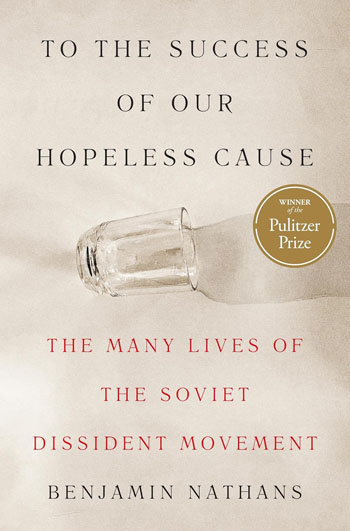TO THE SUCCES OF OUR HOPELESS CAUSE:
The Many Lives of the Soviet Dissident Movement
Benjamin Nathans
ISBN 978-0-691-11703-4

The Soviet dissident movement was more or less set going by the
Sinyavksy-Daniel trial of February 1966. The two writers, who employed the
pen-names of Adam Tertz and Nikolai Arzhak, had their work published abroad,
tamizdat, as it was known, in contradistinction to samizdat, self-published.
The trial was preceded by the glasnost meeting of 5th December
1965 (this is where Gorbachev’s use of the term originated) the first
post-1945 public protest in the Soviet Union, which demanded an open trial
on the grounds that a trial in secret was in breach of the constitution.
Daniel was sentenced to five years in a labour camp, Sinyavsky to seven.
Literature was on trial. All the hacks supported the authorities, as hacks
will; but some writers who might have been expected to be a little more
understanding lined up with State repression and condemned the accused,
Sholokov not the least.
The Khruschev “thaw” had created some space for minimal questioning of the
Party, but Brezhnev was too thick-witted, conformist, sunk in ideological
rigidity and paranoid of all argument to let it continue. The dissident
movement, as Nathans makes clear in this remarkable study, was by no means
united: one of its most interesting figures is Alexander Volpin, poet and
mathematician who wanted to elaborate a political language of pure logic and
who believed in legalism: the regime should be forced to adhere to its own
constitution. Not everyone in the movement agreed. Some viewed an overthrow
of the regime as necessary and, in the long run, inevitable.
Natalia Gorbanevskaya had a song dedicated to her by Joan Baez and a poem by
Adrienne Rich. She is hardly a forgotten figure, but neither is she a
household name, like most of the people mentioned in this study. She is,
perhaps, a good example for focus. In 1956, she was recruited by the KGB to
dish the dirt on two of her friends who had distributed leaflets criticising
the USSR’s repressive actions in Hungary and Poland. Taken to the Lubyanka,
she cracked after thirty-six hours. Her friends were given long prison
sentences. Gorbanebvskaya subsequently accused herself of self-deception and
sank into deep depression. She founded the Chronicle of Current Events,
whose technique was to unearth and present facts, never to appeal to the
reader’s emotions. “Truth is beyond our reach, we’ll settle for the facts”
as a supporter expressed it. It’s a worthwhile observation. The facts have
to form the basis of any interpretation. As David Hume advised, a sensible
person will adjust their thinking to the evidence. However, the facts don’t
entirely speak for themselves. The facts of the Bolshevik revolution are
well known, but they don’t fully explain why it came about. In the context
of a system drowned in propaganda, it was understandable that a retreat to
facts seemed a reasonable defence, just as the constant emotional
manipulation drove to the idea of leaving emotional appeals aside. It is a
measure of the despair which invades totalitarian systems that highly
intelligent, creative people are impelled to such reduced strategies.
Gorbanevskaya’s story takes us to the heart of what this book is exploring.
It is full of minute detail. Its array of characters is enormous.
Nathans’ research is exemplary and
his organisation of his material magisterial. The important point of the
book, however, can be simply and briefly explained: it is characteristic of
our nature to think for ourselves and to give expression to our thoughts; to
be denied those possibilities is to be seriously damaged in your essential
humanity.
If we lived in a world in which free thought and expression flourished, this
book might be a curiosity. As it is, its vital relevance is on every page.
To rehearse its detail, would be a waste, crucial is to suggest why it is
essential reading. Gorbanevskaya, who was a woman of some talent and
courage, convinced herself, under duress, that as a loyal communist it was
her duty to betray her friends. One of the best literary explorations of
this is Milan Kundera’s The Joke. We ought to be so familiar and
well-informed, we know how to resist, yet across the world, authoritarian
regimes are on the rise, backed by large swathes of the common people. An
inescapable feature of authoritarianism is progressive restriction of the
boundaries of free expression. In Orban’s Hungary, for example, the ruling
party can withdraw media licences, fine journalists for trivial reasons and
ownership of the media is passing into the hands oligarchs who support the
regime. Why do the common people not recognise this as a significant
restriction of their freedom? Why, for paltry political rewards and empty
egotism are they willing to toy with the loss of free speech, expression and
organisation? Gorbanevskaya’s appalling betrayal, like much else in this
book, helps us understand. When everybody suspects everyone else, when
everyone is under pressure to conform, to betray their neighbour, friend,
work-mate or family member, it becomes a badge of nobility to join in.
This is the world we are rapidly moving into, where to refuse to support
Trump’s MAGA movement (whatever that is supposed to be) is a form or
treachery, where dissent is evil and the prison or the psychiatric hospital
loom for anyone who refuses compliance. That all this is done in the name of
democracy and freedom is the Orwellian touch.
Nathans has written a most timely book. It is extraordinarily impressive in
is thoroughness. It’s hard to imagine a study of the same subject to rival
it will come along soon. Its real power is in its reminder of how
devastating to human dignity is totalitarianism, or anything like it. It is
a defence of the right to say and write what authorities of all kinds
loathe, and of to organise, protest and agitate with no limit except doing
no harm to others.
.